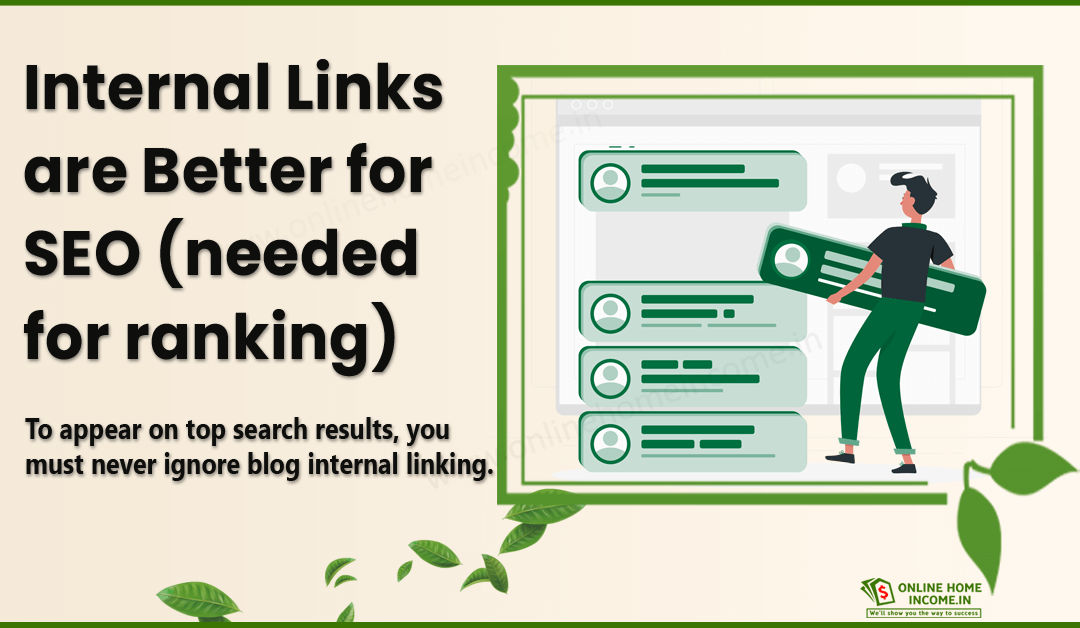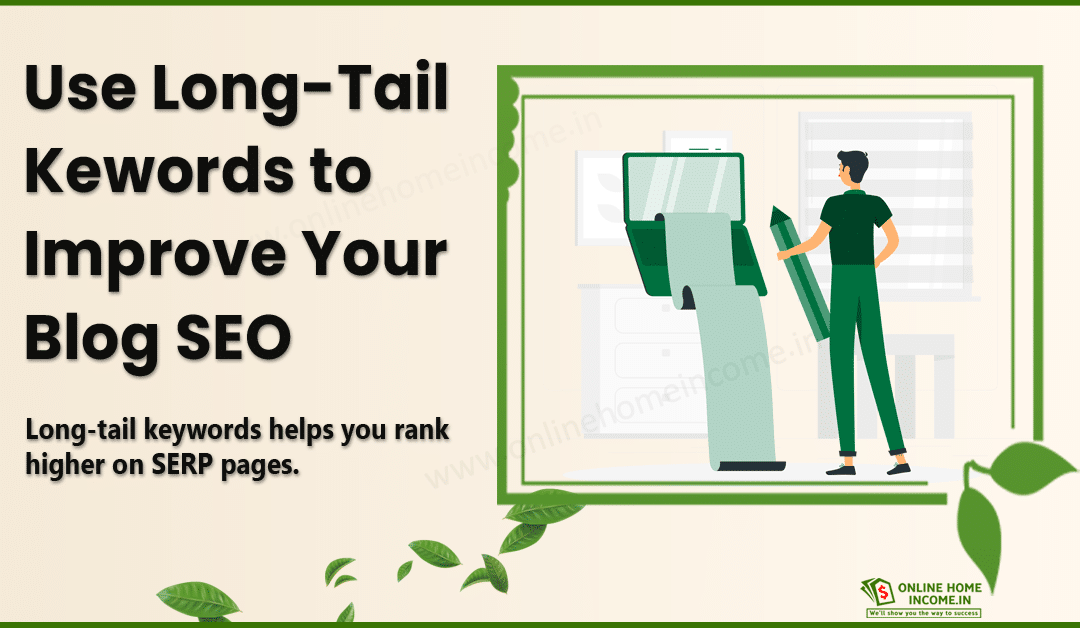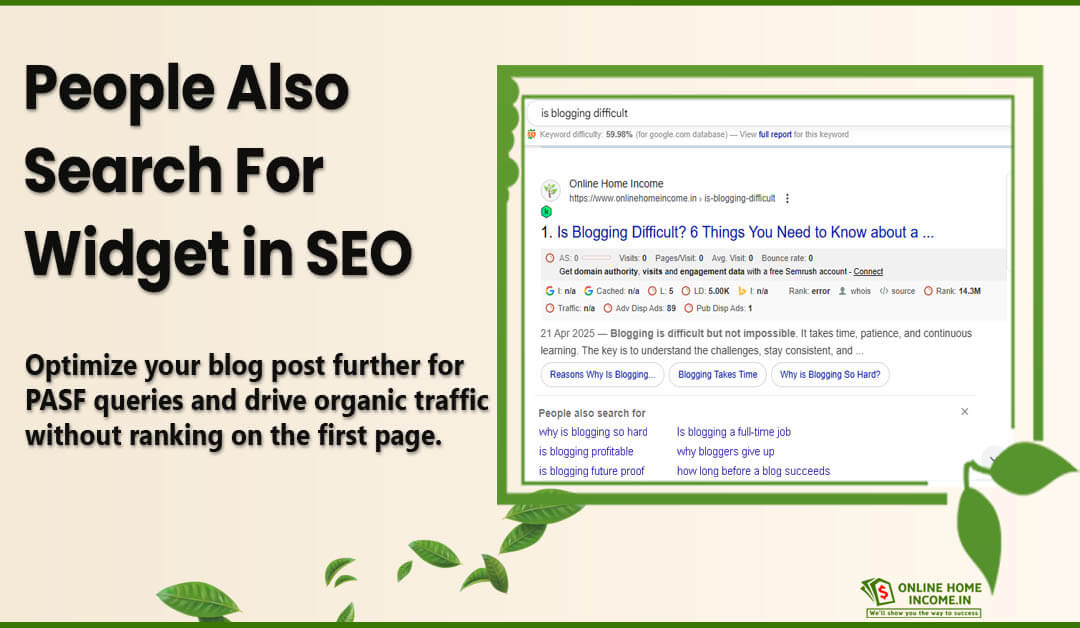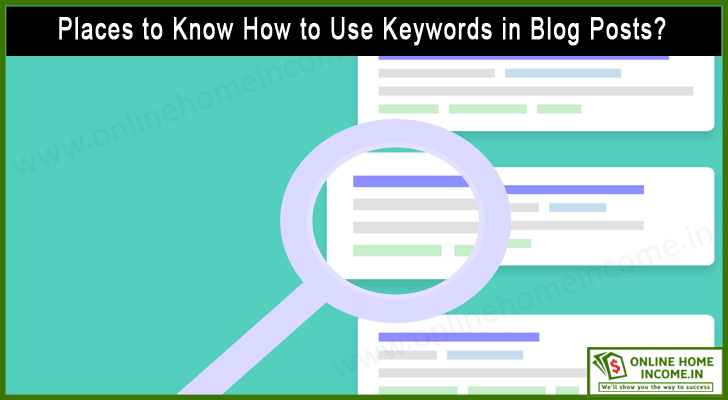Follow the best practice to write an SEO-friendly blog post in 2025 and optimize your article to rank in the top position in the search engines.
Writing is an art, and it requires skill. You have to learn the art of keeping your readers engaged by writing an interesting SEO-friendly article.
Nowadays, blogging is the most successful business across the globe. Many people are getting into this field after seeing its immense potential in online money-making.
The true success of a blogging business depends on the volume of quality content published. If people like your article and can understand it, they will share it with others.
It will help you gain ranking and improve your blog’s position in the search engine result pages. Your content determines your blog’s success.

This blog post is for bloggers who want to improve their blog ranking and content writing skills. Practically writing for SEO, along with attracting readers, seems to be a daunting task.
But if you put in consistent effort, you can easily adapt to writing SEO-friendly articles. The articles are constructed around keywords.
The different types of keywords are primary keyword, secondary keyword, latent semantic indexing keyword, and long-tail keyword.
Be aware that overusing keywords severely affects your search ranking and also annoys readers. It will depreciate your reader’s interest, which no one doesn’t wants to do.
So, spend your next few minutes reading this entire article to learn the art of running an SEO-friendly blog.
1. Think Before You Write!
Acting without a plan can be disastrous. The same principle applies to content writers also. Being SEO Content Writers, we need to have a plan before beginning our writing.
Well, we know that we are going to write for the people in a way that the search engine can also understand.
Before you start to write an article for SEO, think about the following criteria.
- What do you want to write in this article?
- What are the topics to cover?
- The main purpose of the article.
- Define the target audience market (location, etc).
- Finally, what do you want your readers to do after reading the article?
First, write down the answers to these questions, and it will help you on how to get blog post ideas.
So, where do I get ideas, and how?
I suggest you look at the search results for the search keyword (or topic) for ideas.
2. Create a Structure for Your Blog Post
You cannot simply write a long paragraph for an article. It will bore readers, and search engines also cannot able to understand the context of the article.
Hence, before writing an article for your blog, prepare a proper structure for the post. A proper SEO-friendly article must have:
- An Introduction (about the subject or topic).
- Body of the article (the information about the entire topic is covered here).
- A Conclusion (where you summarize the topic ideas).
Structuring a blog post improves readability and helps your readers understand the context.
If the readers find it easy to read, they share it with others.
Create a list of topics, like main headings and subheadings, to break long paragraphs. Add bullet points in between the paragraphs to highlight the important message.
Google and other search engines notice such user signals, which will help improve your organic ranking.
Nowadays, structured and readable blog posts tend to rank better in search results. Now happens the exact SEO writing.
3. Craft an Impressive Title and Description
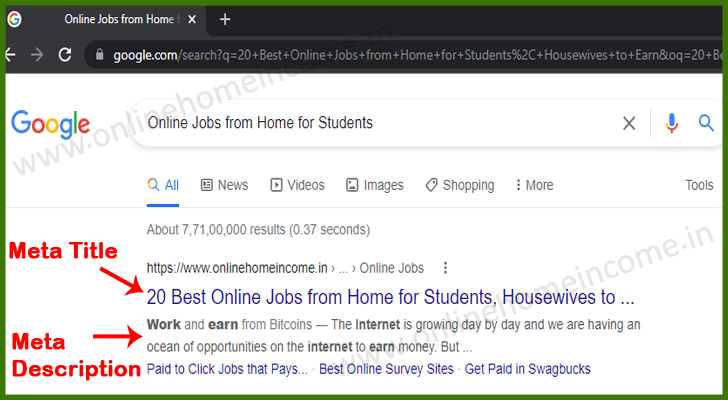
Now comes the important aspect of writing SEO-friendly blog posts. It is to write an impressive blog post title and description.
Write a convincing title that creates curiosity among the readers to click your link snippet in the search results.
A report states that more than 78% of clicks happen only on the top 10 results. You have to face heavy competition to push your blog post below the 10th position.
Even though your responsibility will increase here, as you have more pressure to write a compelling title and description.
Most users care about reading the title and description before clicking the link to land on the blog.
So next time, you must pay more attention to writing a blog post title. Search engine bots give more importance to Post Titles and Description before scanning the rest of the article.
An optimized SEO title gives hints to the Search engines. So, what are the characteristics of a good title?
- A good SEO title should be between 55 – 60 characters in length.
- The title must have a focus (target) keyword.
- It should describe your entire article context.
- A good title should trigger curiosity among the readers to click your link snippet.
Content Writers know what powerful words, emotional words, and unique words.
Pay attention to adding enough powerful words and writing an emotional title to attract more readers.
You can also use secondary keywords, LSI keywords, or even long-tail keywords to keep the title and description interesting to read.
4. Use Paragraphs, Headings, and Sub-Headings
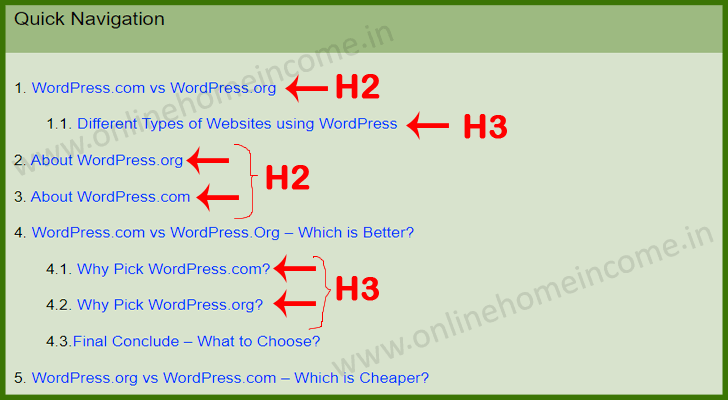
Readability is an important element of an SEO-friendly blog post, and to achieve a good score, we need to follow some rules.
Readers and search engines find it difficult to read a long paragraph. So, it becomes necessary to break them into small paragraphs and sometimes into small sentences.
This improves your readability score and also helps to pleasantly present your article. Add proper headings and subheadings between the paragraphs.
Use H1 one-time: The H1 (or post title) and Meta title are the same. You should use an H1 tag only once in your article, including your target keyword.
Use headings in hierarchical mode: There are six (6) header tags available. They are H1, H2, H3, H4, H5, and H6. The main title of the post is H1, and the main section should be H2.
You can check the H1 tag count using the Tag Checker by Sitechecker. This tool will also show the length of the H1 tag and whether H1=Title.
If you are further breaking down into sub-sections, use H3, H4, and more in sequential order. Shuffling header tag positions will hurt your search engine ranking.
That’s why I am suggesting you create a post structure before starting to write an SEO-friendly article. It makes the process easy, such as adding headings, sub-headings, etc.
The final output of the post will look nice and easier to read and understand.
5. Write for Humans, Not for Search Engines
SEO stands for search engine optimization. It is the process of ranking a blog to the top position of search engine result pages for a target keyword.
So, you must have to write an article that is SEO-optimized to gain a better ranking. So far, it is correct.
But still, many bloggers think that writing an SEO article means just following the SEO rules.
It means adding H1 tags and other header tags with keywords, adding image alt tags, and more.
But literally, SEO is the process of providing a solution (or an answer) for the user’s search.
The process of understanding the reader’s query (intent) and suggesting a proper solution through the blog post.
Search engines also move towards providing the best answer for the query. If a user has a query, he/she simply search for an answer on the search engines like Google.
The best method for you to rank your article is by writing quality blog posts. Do small research to understand the audience’s personas, interests, challenges, and motivations.
Then, find a suitable topic that resonates with their pain points. Bridge them by writing an organized blog post using headings, subheadings, bullet points, and other visual aids.
Visual elements aids such as images, statistics, infographics, etc. Google and other search engines always admire content that is easy to read and understand.
6. Start with Keyword Research
To understand the need for keyword research, you must know how search engines work.
Search engines have four primary functions. They are crawling, indexing, ranking, and fetching.
Search engines provide an HTML form where users enter their queries. Based on the query, it returns the best results to the users.
The queries are technically called Keywords. So, now you understand the need for keyword research and how it plays a major role in SEO-friendly article writing.
A report by Google states that it processes over 1 million search queries a second. So you think to yourself, how many results does it produce every second?
You need to push down all these output links to climb and show up in the top ten search engine results.
Here’s where you tap large potential customers into your business. Just think on the flip side, how do people find your blog if there is no search engine?
So, do not take this as simple and start doing keyword research. There are tools such as Google Keyword Planner, Ahrefs, SEMRUSH, and Uber.
These tools give you detailed information about the keywords and tell you how popular those queries are.
Before writing an article, keyword research can help you make a decision. It is necessary to conduct keyword research frequently to maintain your ranking position.
7. Use Transition Words and Write in an Active Voice
From the beginning of this article, I insist on the term readability. If you score high enough, your content will likely rank better.
Using transition words in your article helps to enhance readability. It helps readers to scan your blog post and understand the relationship between sentences and paragraphs.
Moreover, transition words help readers get the article’s conclusion.
For example, let’s assume that you are selling a service, and it has three important benefits. Instead of writing them in bullet points, you can use signal words.
Signal words such as “first of all”, “secondly”, and “finally (or at last)”. Google and other search engines measure the user signal to calculate your organic ranking position.
Next, we will see the usage of active voice to write clean and simple sentences for your article.
Another important aspect is making use of active voice to frame sentences. Passive voice makes it difficult to understand the meaning of the sentences.
It requires more cognitive effort from the reader and decreases the likelihood of your getting your message across.
Using an active voice makes your writing more direct and effective. Passive voice makes sentences wordy and complex, where the user has to spend valuable working memory.
I suggest you take a Spoken English course to improve your English for professional and academic blogging.
Whereas the active voice is straight to the subject and directly conveys the message. Thus making the text reading easier.
8. Link to Existing Content (Internal Linking)
Internal linking is an essential part of SEO, and at the same time, it helps improve your SEO article.
This method makes your existing posts stronger because you are adding more value to the topic. Internal linking is one of the organic ranking signals.
Google and other search engines correlate your articles with each other to determine their authority.
Linking to other related articles is a great way to keep your readers engaged within a boundary.
Users will get more knowledge from your previous content, which is likely to increase the social sharing ratio.
It helps them navigate your site for a long time and makes them discover more of your content. This practice increases your level of trust and credibility.
When users stay longer on your blog, it will reduce your site’s bounce rate and contribute to increased conversion.
Also, you should not simply link to other articles or even outside sources using random anchor text. The anchor text is the words used as hyperlinks to link to other articles.
You should be careful in using anchor text, and avoid spammy words and generic calls to action such as “click here”, “cheap products”, etc.
Instead, use descriptive keywords as anchor text to give readers a sense of their requirements. You can even choose meaningful sentences to link to other articles.
Never force-feed links or use any unnatural way to redirect users. Make natural attempts to link the posts.
Internal linking helps search engines discover new pages on your website.
9. Optimize the Length of Your Blog Post
Five years back, if you searched for anything on Google or even other search engines, you might land on a low-value blog.
As the days go by, search engines alter their algorithm to improve their search results. Studies have shown that longer blog posts tend to perform better in search engines.
Because search engines believe that the longer the posts are, the deeper the message. Some topics need not be long. In that case, shorter posts rank well.
However, quality content is more important than quantity. A good SEO-friendly blog is one with a large number of quality posts.
Just keep in mind that you are competing with almost a million results with your article. You should have a valuable reason to beat other articles to rank higher.
Though long articles tend to rank better, it doesn’t mean that you can rank higher. Google requires other on-page SEO factors in evaluating the ranking position.
However, your primary duty is to write an in-depth SEO-friendly article that covers both sides of a story.
Also, add nice images, references, infographics, and useful highlights to get more links to your blog post. I always prefer to write every article between 2100 to 2500 words long.
The more content on your blog post, the more clues search engines have to find out what your blog article is about.
On the flip side, think about the readers; they may be overwhelmed by your long content.
So to make it interesting, break long paragraphs into shorter sentences, add headings, and bullet points. Create a proper structure and make it scannable chunks.
10. Use Images, Add Alt Text, and Compress Images
No one likes to read a long, boring paragraph of text. Even search engines find it difficult to digest your text and come to a conclusion on what the topic is.
That’s why Images play a vital role in increasing readers’ engagement and making them stay longer.
Images, infographics, videos, graphs, statistics, and other media elements make your blog post more interesting.
It enhances the quality of the content and insists that readers consume the entire article. You can add images in your body text and other important places wherever necessary.
You can use featured images to let search engines understand your content and rank in their image search results.
Don’t forget to add Alt Text for all images in the article. Google and other search engines do not have the facility to understand the context of an image or video.
After some days, they can read the text inside an image or video. But I don’t know how much reality it is.
In some cases, if the browser is not able to load images, these alt texts will be displayed. Hence, it should be descriptive.
The image alt tags must include focus keywords, LSI keywords, and secondary keywords.
For example, observe this blog post title, “How to write an SEO-friendly blog post.”?.
And for this article, I have created a featured image, and the alt text should be something like this: “A girl writing an SEO-friendly blog post for her blog”.
Just observe the alt text, which is descriptive in nature and includes the target keyword. This makes sense, right?
Bonus Tip: Update Existing Article and Design a Link Building Strategy
Many bloggers think that if they publish an article, Google will rank it. After that, they go somewhere for other activities like publishing new articles.
They never come back to update this old article with recent latest information. Regularly adding new SEO-friendly blog posts tells Google that your website is live.
Likewise, it is important to update your existing article with up-to-date information.
Don’t just update the post for the sake of modifying the date. Instead, add the informative, well-written latest content to the post.
I suggest you maintain an editorial calendar that helps you with the process. You are competing with other brands and bloggers in this blogosphere.
Therefore, you should find all possible ways to promote your blog and gain authority. Backlinks play a major role in improving the blog’s authority.
As a blogger, apart from writing SEO articles, you should spend enough time building links from other trusted sources.
You can do guest blogging, write for some publications, ask for links, etc. The more you build links, the more your blog ranks.
Conclusion
It was a decade old, and a few SEO tricks were enough to rank your blog. Those days are gone by 2025.
Nowadays, quality content is the king, and technical SEO is the queen. Good and quality content always gets more likes, shares, tweets, and returning visitors.
SEO is a never-ending process, and you have to keep yourself updated. Still, there are so many things you can do to maximize your site’s SEO friendliness.
In this article, I have shared a few basic tips for a strong foundation. Always do thorough research before starting a new SEO-friendly blog post.
Spend enough time doing your research and preparing all the essentials before the actual start. You can use the above tips listed in this article to optimize your existing posts.
It’s time to make the necessary changes to your SEO. If you are just starting, don’t lose hope.
The results are not immediate, but definite. Follow the above advice and keep publishing high-quality blog posts on your blog.


